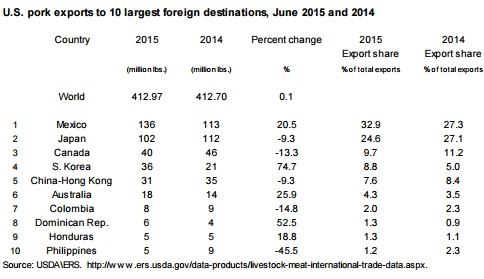USDA lowered its second-half 2015 price forecasts for live equivalent 51-52 percent lean hogs, as July prices came in at lower levels than expected. Thirdquarter prices are expected to be $51-$53 per cwt, almost 38 percent below prices a year ago. Fourth-quarter prices are expected to be $45-$47, 31 percent below the same period a year ago. Pork production in the second half of 2015 is expected to be significantly higher than in the same period last year, as the U.S. pork industry continues its recovery from Porcine Epidemic Diarrhea. Third-quarter commercial pork production is expected to be almost 6 billion pounds, over 10 percent above a year ago. Fourth-quarter production is expected to be 6.5 billion pounds, 6 percent above the same period a year ago.
Exports Lackluster in June
U.S. pork exports in June were almost 413 million pounds, fractionally higher than volumes shipped one year ago. The 10 largest foreign destinations for U.S pork exports in June are listed below. It is notable that shipments to Mexico were nearrecord large at almost 136 million pounds and 21 percent ahead of exports in June 2014. In light of the sharp depreciation of the Mexican peso—which in June had lost more than 19 percent of its value vis-à-vis the U.S dollar, compared with June 2014—the spike in U.S pork shipments to Mexico is likely due to Mexican consumers substituting pork for more expensive meats. U.S Customs data shows that export shipments of beef, broiler meat, turkey, and eggs all declined year over year in June: U.S. beef exports to Mexico in June were 24 percent below a year ago, mostly due to high U.S. prices from lower beef supplies. June shipments of U.S poultry products were all lower year over year due to Avian Influenza-related trade restrictions: broiler meat (-15 percent), turkey (-45 percent), other chicken (-9 percent) and eggs (-51 percent). Lower U.S. beef and poultry product shipments to Mexico reduce domestic (Mexican) availability, likely raising consumer prices. Supplies of U.S. pork products, on the other hand, remain adequate and attractively priced relative to other animal proteins available for export to Mexico.

Source: USDA